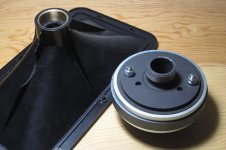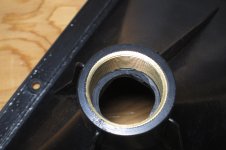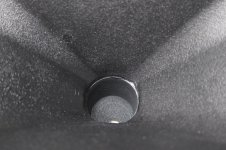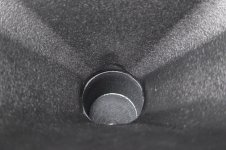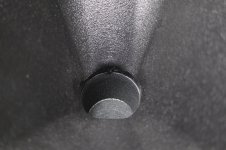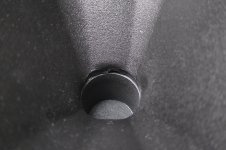I have a pair of flange-mounted Eminence horns and a set of Dayton H6512 waveguides to compare sound for a 2-way speaker. I will mount both in a simple chipboard prototype box and see how they measure and sound to my ears before I advance to the final routed cabinet.
Despite the quality Eminence screw-on adapter EB 2 SA there is naturally a small but pronounced gap between the aluminum adapter and the waveguide's plastic. I made some pictures for you, the gap is only thin, but I think it has to be filled and also the plastic to be smoothed where it protrudes, for which a file can be used. But what do you use to fill/modify the surface of waveguides/horns? Here it should stick to the waveguide I think. Can you name some suggestions which I can buy preferably in Europe or give the technical term for a brand product which may only be available on your continent?
Regards
Despite the quality Eminence screw-on adapter EB 2 SA there is naturally a small but pronounced gap between the aluminum adapter and the waveguide's plastic. I made some pictures for you, the gap is only thin, but I think it has to be filled and also the plastic to be smoothed where it protrudes, for which a file can be used. But what do you use to fill/modify the surface of waveguides/horns? Here it should stick to the waveguide I think. Can you name some suggestions which I can buy preferably in Europe or give the technical term for a brand product which may only be available on your continent?
Regards
Attachments
I was rather thinking of something permanent but also, clay may easily fall off once dried because it has no power to stick to a non porous surface like plastic.
I also asked the my local art material supply for a form of sticky non-hardening material that a user once suggested but they could not come up with it. I think it was modelling clay the sort children use to their fun and the demise of the interior. Someone had experience with this?
I also asked the my local art material supply for a form of sticky non-hardening material that a user once suggested but they could not come up with it. I think it was modelling clay the sort children use to their fun and the demise of the interior. Someone had experience with this?
Last edited:
Are automobile body fillers / wood fillers suitable for this purpose ? I have plans to CNC a wooden horn in parts (slices) and have been thinking about using wood waste powdered and mixed with glue.
Sheeple: I suggest using some plumber's teflon tape on that screw.
Sheeple: I suggest using some plumber's teflon tape on that screw.
Last edited:
I would suggest plumbers putty because it stays flexible but it has a bad habit of drawing the plasticizers out of plastic making it brittle with cracking ensuing.
The gray duct seal that i have used on residential and commercial ductwork I've gotten from the hvac suppliers does harden and is very toxic during application.
Maybe try clay mixed with a bit of wood glue so it won't fall apart.
Bondo works great for most speaker apps.
I would rough up the surface w 80 grit for whatever you end up applying.
HTH.
The gray duct seal that i have used on residential and commercial ductwork I've gotten from the hvac suppliers does harden and is very toxic during application.
Maybe try clay mixed with a bit of wood glue so it won't fall apart.
Bondo works great for most speaker apps.
I would rough up the surface w 80 grit for whatever you end up applying.
HTH.
Last edited:
The Gardner Bender 1lb brick of duct seal I use to add mass to woofers (for T/S measurements) is still pliable after 6 years use. It is pretty harmless: https://www.gardnerbender.com/-/media/inriver/DS-130_TCHDAT_SDS.pdf?modified=20210329153443
https://www.lowes.com/pd/Gardner-Bender-16-oz-Duct-Seal/4595233
The Duct Seal 1 lb. Compound Plug is ideal for sealing and protecting gaps, holes and conduit openings against dust, moisture, drafts and noise. This easy-to-handle compound is non-conductive, non-toxic and non-deteriorating and will not harden or form a skin under normal conditions.
https://www.lowes.com/pd/Gardner-Bender-16-oz-Duct-Seal/4595233
Last edited:
- Status
- This old topic is closed. If you want to reopen this topic, contact a moderator using the "Report Post" button.
- Home
- Loudspeakers
- Multi-Way
- what do you use to fill gaps in waveguides/horns?
